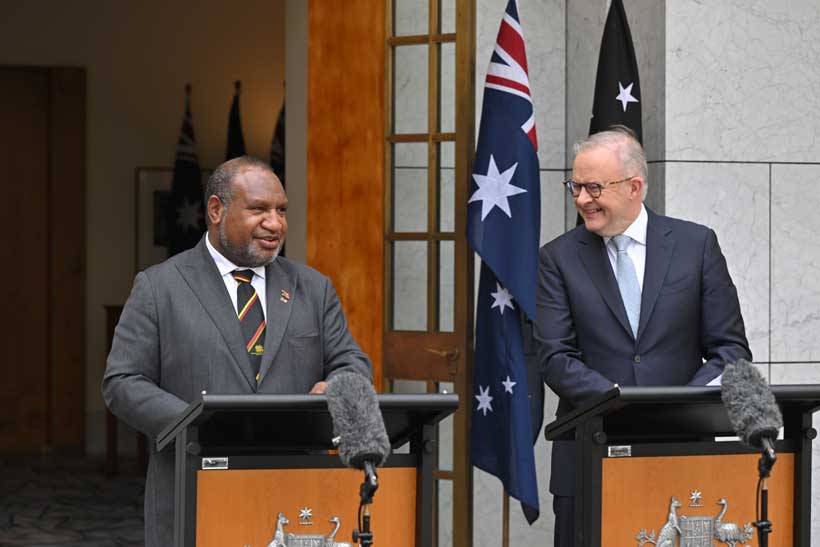Australia and Papua New Guinea (PNG) solidified a defense pact in a formal declaration on October 6th, 2025, in the Australian capital of Canberra. The mutual defense treaty is a milestone deal for the Indo-Pacific, enabling both Port Moresby and Canberra to secure their flanks against China’s regional threats while improving and strengthening bilateral relations.
Amid regional turbulence, growing defense cooperation between Canberra and Port Moresby helps secure the southernmost quadrant of the Indo-Pacific. Furthermore, Australia and PNG, with successful collaboration, have the opportunity to extend bilateral ties, which are needed to combat and deter various regional threats.
The Australia-Papua New Guinea Defense Pact
Amidst a month delay, Australia and Papua New Guinea signed the Pukpuk Treaty for mutual defense and cooperation on October 6th. The treaty is the first for PNG, which started growing military cooperation in 2023 when the then Biden Administration authorized the Defense Cooperation Agreement in May of that year.
For Australia, the country continues to branch out with its second crucial military defense pact in the Indo-Pacific since ANZUS with the United States and New Zealand in 1951. The Pukpuk Treaty follows the trilateral submarine security pact of AUKUS and the Five Power Defense Arrangements (FPDA), which will help grow Canberra’s security apparatus.
New security pacts are part of a multi-year effort from Australia to build relations in the Indo-Pacific as threats from China and Russia grow. For PNG, Port Moresby is strengthening its defense apparatus with one of its strongest allies, which will benefit the country in the long term through future regional cooperation.
Australia was able to seal a landmark security pact by utilizing key areas of soft power, not only with technology, security, and trade, but also through sports. The Labor government finalized a $400 million USD sports deal to integrate Papua New Guinea into the National Rugby League, which helped curb Chinese influence.
How Canberra and Port Moresby Benefit from Each Other
The mutual defense treaty increases joint military exercises and technology and intelligence sharing and further allows 10,000 PNG troops to serve in the Australian Defence Forces (ADF). With recruitment woes being a major concern in Australia, the allocation of PNG forces into the ADF gives Australian forces a gateway to jump over the hurdle.
For Papua New Guinea, consolidating a mutual defense pact with Australia helps the country enhance its response time to humanitarian crises. Noted by the Australian Strategic Policy Institute (ASPI), Canberra is a major partner for crisis response and relief efforts for major disasters that Port Moresby has faced in recent years.
Regarding capabilities, the Pukpuk Treaty enables the ADF to enhance PNG’s maritime and aerial capabilities, supporting its military modernization efforts in the region. Likewise, the pact negates freedom of movement for China in the Pacific Islands after Beijing rapidly expanded with the 2022 Solomon Islands security agreement.
Hurdles in the Mutual Defense Agreement and Regional Expectations
Despite the landmark Pukpuk Treaty, Port Moresby operates a “friends to all” foreign policy and, therefore, will be unlikely to join Australia in a wide conflict in the Indo-Pacific unless attacked first. Nevertheless, by opening up Papua New Guinea to new opportunities and sectors of defense and trade, Chinese influence can be negated in Australia’s Northern and Western territories.
The February 11th incursion by China’s navy (PLAN) through the Tasman and Coral Seas highlighted the need for countermeasures, as the PLAN’s lack of warning hindered commercial flights. If such an incursion were to happen in the future, Australia would need to be prepared, which the Pukpuk Treaty with PNG brings.
Outside of Australia and Papua New Guinea, New Zealand can also grow its defense apparatus with the latter, as Wellington already has the aforementioned defense pact with Canberra (ANZUS). The New Zealand Defence Force (NZDF) can also help train, advise, and assist the PNG military, which would supplement the training and modernization program the ADF looks to implement from the Pukpuk Treaty.
Growing relations between various countries in the Indo-Pacific are needed more than ever, as the U.S. government under the second Trump Administration is now prioritizing the Americas and national security more than Asia. Australia is adopting a more proactive stance towards the Pacific Islands, aligning with Papua New Guinea and reassuring other countries, such as Indonesia and New Zealand, that there will be no competing interests or conflicts.
Today, the primary objective of the Pukpuk Treaty is to modernize Papua New Guinea’s military, address the gaps in ADF recruitment, hinder Chinese influence in the Pacific Islands, and prepare for all contingencies if global foreign relations become unorthodox or unpredictable, as seen with the current U.S. government strategy.
Growth and Challenges in the Australia-Papua New Guinea Defense Pact
Australia and Papua New Guinea (PNG) solidified a defense pact in a formal declaration on October 6th, 2025, in the Australian capital of Canberra.


